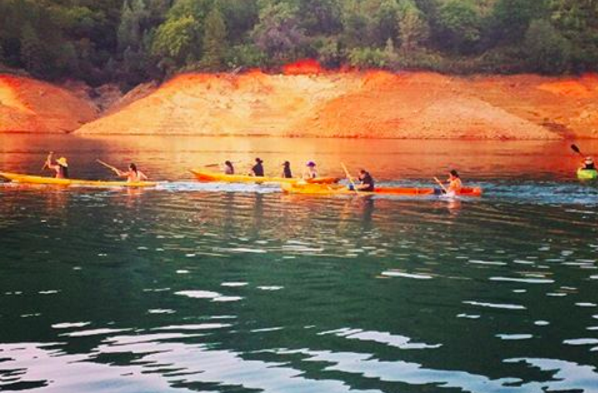In September my people, the Winnemem Wintu, embarked on a 300-mile (480km) journey to bring attention to the policies threatening our waters, our fish and our way of life. Joined by a collective of Indigenous women, activists and friends, we traced the historic route of our sacred salmon from the San Francisco Bay Delta to their ancestral homeland in the McCloud River north of Redding, California. The rivers and tributaries that served as the pathway home for the winter-run chinook have been blocked, drained and diverted over seven decades of destructive California water mismanagement. So we did not swim – instead we covered the winding miles in our Run4Salmon in stretches by boat, by foot, on bicycles and by horseback.
For more than 6,000 years, our people have lived along the McCloud River at the base of Mt. Shasta, the sacred mountain and the main source of California’s freshwater, which flows from the mountain’s spring into the Sacramento River all the way to the Pacific Ocean. If our water is poisoned, so too is California.
The last chief, my great-auntie Florence Jones, who was born in 1905, was a young woman when the Bureau of Reclamation cleared us out of our villages and bulldozed our homes to build the Shasta Dam. The reservoir flooded more than 90 percent of Winnemem Wintu villages, sacred sites, burial grounds and cultural gathering areas along the Sacramento, McCloud and Pit rivers. We were never compensated with the land or means promised to us through an act of Congress signed in 1943. The Sacramento River, once California’s steadily pumping artery, was clogged – and the water became still and stagnant.

Participants in the Winnemem Wintu’s Run4Salmon paddle on Lake Shasta. (Winnemem Wintu)
Blocked by the Shasta Dam, our salmon, the winter-run Chinook, could no longer make the passage up to the cold, high-elevation waters of the McCloud. I am the first chief in our people’s history to have never seen the salmon return to their spawning waters. The salmon were more than just a source of food or an economic means for us. Our lives, our livelihood, our spiritual practices, our identity and the health of the natural world are tied to the salmon.
The waters below the dam have since been rerouted through a complex series of pumps, reservoirs and canals that have wreaked further havoc on the health of the natural world, leaving winter- and spring-run Chinook salmon, Central Valley steelhead, the southern population of North American green sturgeon and southern resident killer whales facing extinction.
But now, the U.S. Bureau of Reclamation, Westlands Water District and Senator Dianne Feinstein want to raise the height of Shasta Dam by 18.5ft (5.5m). Gov. Jerry Brown wants to build two giant tunnels through the Sacramento-San Joaquin Delta that will divert more freshwater from the Sacramento River to the heavily subsidized commercial agricultural industry that built its thirsty empire in a desert. If completed, these projects will kill the largest estuary on the Pacific coast, inundate future spawning grounds on the McCloud River and flood the remaining Winnemem Wintu sacred sites.
The impact will be felt not just by us. These projects will poison the soil and destroy unique habitat that is essential for salmon as well as other plants, birds and marine life, leaving delta farmers, fishermen and millions of water users in Northern California high and dry.
Water is life. It is a simple concept that young children understand. Without clean water, we sicken and die. Yet, to a handful of very wealthy and powerful agricultural users in the Central Valley – and the agencies and politicians they bankroll – water is not a promise of life. It is a commodity to be pillaged and sold.
We call on Sen. Feinstein, Gov. Brown and the agencies to discard these ill-gotten and illegal projects and look instead to responsible water management and restoration of the salmon to their home waters through the construction of a fish volition passage around the Shasta Dam. We call on these leaders to look into their hearts and ask themselves if drowned cultures, dead and extinct fish, broken promises, environmental destruction and stolen water are really worth the cost.
The views expressed in this article belong to the author and do not necessarily reflect the editorial policy of Water Deeply.
